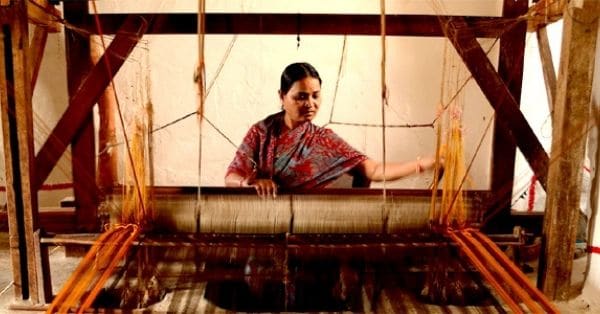
Indian Handloom Industry is a very vast phenomenon. If you want to get a proof of this then you can read the Ramayana and the Mahabharata which have evident information about the same. Some of the evidence also states that the Indian Handloom Industry is around 5000 years old and that’s a lot of time! We have been creating beautiful designs using Handlooms for the past 5000 years! India also has a history of exporting Handloom fabrics to some big countries.
India is a home to tradition. However, when the colonising hit our country it created a very bad impact upon the handloom sector of the country also. When the people were actively using natural fibres, the handloom industry was a sight to cherish but slowly and gradually weavers started to shift from natural fibres to synthetic fibres. Weavers shifted to synthetic fibres like polyester. Polyester is known for producing water waste which results in water pollution.
The History of Handloom
In the olden times, people actively used charkha for spinning cotton to make it a fabric. In each and every village of India, a separate weavers community was present which produced Handwoven and Handspun fabrics from small instruments like Charkhas. But due to British rule, many things turned upside down for the handloom sector of our country.
Now, India was only the exporter of raw cotton. The British officials introduced machine-made yarn into the country and forced the weavers to stop their production. That was the reason due to which most of the weavers lost their job in the country. Gradually, the handloom industry suffered more and more due to the middlemen who created disputes. With the beginning of machines and power looms, the handloom sector slowly totally vanished.
The Gandhian Era
To help the weavers of India continue their work and support the tradition of India, Mahatma Gandhi started the Swadeshi Movement. The Swadeshi movement helped the people continue the use of khadi and promote Indian fabrics. Mahatma Gandhi encouraged each and every Indian to use Charkha and spin their own yarn. Each and every Indian supported the Swadeshi movement and this created a huge impact upon the economy of that time.
People started protesting on the streets and also burnt down the synthetic fibers which were given to them by the British rules. A lot of mills were destroyed by Indians during the Swadeshi movement. However, even after getting independence, there are a lot of mills in India still present but Khadi is always respected. Khadi fabric is a fabric that is built by hand spinning yarns. Khadi is still provided importance and protection against unfair means and competition.
Condition of Handloom Today
The condition of the Handloom sector in India is degrading day by day because of the cost of natural fiber. The cost of natural fiber is going up because people are not interested in buying the natural fibers of their country. A lot of synthetic fibers are preferred by the Indians today because of their cheap price. Also, because a lot of Indians do not understand the concept of sustainable fashion. Due to the higher cost of natural fibers, the common man of India cannot even think of buying any Khadi product.
However, the higher cost of natural fibers does not mean that the weavers are also paid a very huge amount. Instead, research shows that the salary of weavers is frozen for a long decade. A large number of weavers are now planning to give up their passion for creating beautiful clothes. These people will then go for the job of unskilled labor. Poverty has definitely hit the weavers community very deeply.
The Beauty Of Handloom
The Handloom sector of our country is definitely the most beautiful sector and the closest to our tradition. When you buy a Handloom piece, you will definitely feel much rooted in your tradition and your culture. The Handloom sector brings back the memories of our home country. The effort and the passion which the weavers put into one piece of fabric is immaculate. And how can one forget the love that is put into a fabric which is woven and spun by hands.
If you want to revive the handloom industry we need to take care of the fabrics that we are buying from our local market. Sometimes, we buy clothes which are of cheap quality just because they are in trend. Indians actually love fast fashion and buying cheap clothes of synthetic fibres every now and then is proof of it. Reviving the handloom industry can definitely be a long process but it will not be a really difficult one. Many people are now advocating sustainable fashion and that can be a really great step towards the development of the handloom industry in our country.
Distinct Weaving Styles
Each and every weaver has his own style. You can never get the same style from every weaver. It is also said that there are around 20 to 30 different weaving styles present in a particular region. India is a home to varied weaving styles and you can never get enough of handloom pieces because there is so much to look for in this industry and sector. The only thing that you can do is discover and try each and every weaving style present in this country so that you can touch the roots and clearly understand the tradition of Handloom.
If you want to try different handloom sarees and understand your tradition more clearly then you can shop now from Loomfolks. Loomfolks offers designer and unique handloom and handwoven embroidery sarees apt for each and every occasion. Help us light the houses of Indian weavers today!
